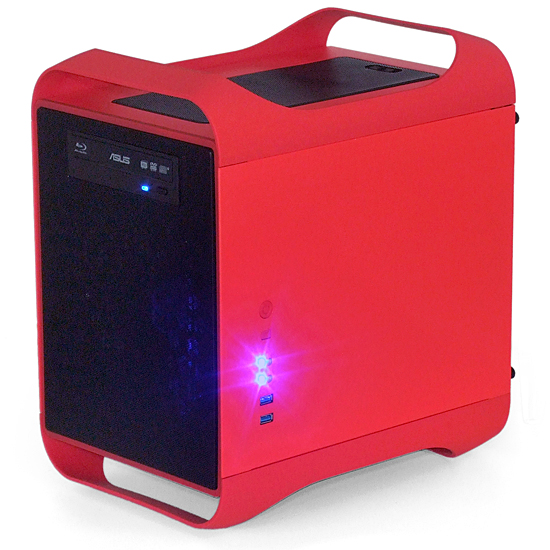System Builder Marathon, Q2 2013: $2500 Performance PC
ITX And DTX: When Less (Space) Costs More (Money)
System Builder Marathon, Q2 2013: The Articles
Here are links to each of the four articles in this quarter’s System Builder Marathon (we’ll update them as each story is published). And remember, these systems are all being given away at the end of the marathon.
To enter the giveaway, please fill out this SurveyGizmo form, and be sure to read the complete rules before entering!
Day 1: The $650 Mini-ITX Gaming PC
Day 2: The $1300 Mini-ITX Enthusiast PC
Day 3: The $2500 Mini-Performance PC
Day 4: Performance And Value, Dissected
Day 5: The $400 "True Spirit of Mini-ITX" PC
Introduction
Your feedback plays an important role in determining the direction our System Builder Marathons take. When we've exhausted every other way to spend our budgets trying to build conventional-looking boxes, we turn to the comments section for inspiration. Compact gaming systems seem to come up regularly, particularly at a time when more efficient computing architectures and lower-power graphics cards inspire creativity. So, when Don and Paul put their support behind a mini-ITX-themed Marathon, I hopped on-board as well.
Knowing that mini-ITX is particularly popular right now, I suppressed the cynicism that you know and love. My only complaint was that I'd pay $50 more for a motherboard with $50 less worth of features. Then again, I’m the guy who reviews all of our motherboards. I'm really picky about this stuff. Rather than argue the technical superiority of micro-ATX, I embraced the convenience of DTX.
Get Tom's Hardware's best news and in-depth reviews, straight to your inbox.
In spite of what my colleagues might believe, this isn’t a mini-ITX system round-up. VIA's single-slot mini-ITX form factor limits its motherboard, but a system's form factor is that of its enclosure. AMD’s DTX form factor adds the second slot needed to support a majority of high-performance graphics cards, and that explains why the majority of ITX gaming cases are actually DTX-compliant. Though motherboard makers aren't taking advantage of the added depth available to true DTX motherboards—supporting larger voltage regulators and more DIMM slots—the empty motherboard space is still available in DTX-based “ITX gaming cases”.
This $2500 "mini-ITX" system is big, even by the larger DTX standard. Yet, its internal components dictated case selection. The combination is as close as a home builder can get to a custom-engineered assembly using retail parts.
| Q2 2013 $2500 Performance PC Components | ||
|---|---|---|
| Processor | Intel Core i7-3770K (Ivy Bridge): 3.5 GHz Base Clock Rate, 3.9 GHz Max. Turbo Boost, Quad-Core, 8 MB Shared L3 Cache | $330 |
| Graphics | Asus GTX690-4GD5 GeForce GTX 690 4 GB (2 GB per GPU) | $1000 |
| Motherboard | Asus P8Z77-I Deluxe: LGA 1155, Intel Z77 Express | $185 |
| Memory | Crucial Ballistix Tactical BLT2K8G3D1608ET3LX0: DDR3-1600 C8, 16 GB (8 GB x 2) | $115 |
| System Drive | Mushkin MKNSSDCR240GB-DX: 240 GB, SATA 6Gb/s SSD | $185 |
| Storage Drive | Western Digital WD2002FAEX: 2 TB, SATA 6Gb/s Hard Drive | $160 |
| Optical | Asus DRW-24B1ST: 14x BD-R, 16x DVD±R | $99 |
| Case | BitFenix Prodigy BFC-PRO-300-RRXKR-RP | $90 |
| Prodigy Mesh Front Panel C-PRO-300-KRFXA-RP | $25 | |
| BitFenix 140 mm Fan BFF-SCF-14025WW-RP | $12 | |
| SilverStone FF143B 140 mm Dust Filter | $10 | |
| Power | Seasonic SS-660XP2: 660 W Modular, ATX12V v2.3, 80 PLUS Platinum | $140 |
| CPU Cooler | NZXT Kraken X40 RL-KRX40-01 | $100 |
| Row 13 - Cell 0 | Total Cost | $2451 |
Originally I was given $2600 to spend (that's four times Paul's budget and two times Don's). But I wasn't able to come up with a performance justification for spending any more than I did. I gave up at $2450 and made the unilateral decision to call this a $2500 build.
Current page: ITX And DTX: When Less (Space) Costs More (Money)
Next Page Motherboard, Graphics, And CPU-
sherlockwing Interesting $2500 MITX build, granted most people(including me) would have built a $2500 rig around 780 SLI in a ATX case.Reply -
burnley14 This just might be my favorite SBM ever, and this particular build my favorite machine of all time. Even if the relative value is slightly lower, many people including myself are willing to pay a small premium for a smaller footprint. Well done!Reply -
slomo4sho Seems I was pretty close in my initial guess:Reply
11002870 said:PCPartPicker part list / Price breakdown by merchant / Benchmarks
CPU: Intel Core i7-3770K 3.5GHz Quad-Core Processor ($319.99 @ Newegg)
CPU Cooler: Corsair H110 94.0 CFM Liquid CPU Cooler ($119.99 @ Newegg)
Motherboard: Asus P8Z77-I DELUXE/WD Mini ITX LGA1155 Motherboard ($207.55 @ Newegg)
Memory: Corsair Dominator Platinum 8GB (2 x 4GB) DDR3-2133 Memory ($149.99 @ Newegg)
Storage: Samsung 840 Series 500GB 2.5" Solid State Disk ($353.98 @ Newegg)
Storage: Western Digital Caviar Black 2TB 3.5" 7200RPM Internal Hard Drive ($159.99 @ Newegg)
Video Card: Asus GeForce GTX 690 4GB Video Card ($999.99 @ Newegg)
Case: BitFenix Prodigy (Black) Mini ITX Tower Case ($95.98 @ Newegg)
Power Supply: SeaSonic 660W 80 PLUS Platinum Certified ATX12V / EPS12V Power Supply ($148.54 @ Newegg)
Optical Drive: LG WH14NS40 Blu-Ray/DVD/CD Writer ($59.99 @ Newegg)
Total: $2597.99 -
agnickolov I wish the build had a 512GB SSD, but I understand the builder's value sentiment. The fast HDD is pure waste, however. A 2TB HDD can be found for under $100.Reply -
sarinaide Still struggling to get my mind on a high performance ITX system, to me its more a case of how much high end you can chuck into a psuedo M-ITX chassis which for all intents and purposes are not small form factor by any stretch of the imagination. Having owned a Prodigy they can hardly be said to be SFF when their total surface area is as much as a ATX chassis, it is like calling a HAF XB M-ITX.Reply
The main point of the article is that diminishing returns are high at that price point, only a overclocked system (again not a fan of in the confineds of a ITX system) give it value. -
csf60 I would take a 770 and water-cool that rig any day, but I suppose that's personal preference.Reply -
sarinaide It is safe to say that the purpose of the machine is gaming, for that is there any particular reason to go with the i7 other than to say you maxed the platforms highest capable chip but in terms of true benefits there is little over an i5 yet over a $100 been dropped on it. The next question is why not a GTX Titan, most of a 690 's performance but on less power and heat which is quite punishing in a Prodigy's confinds.Reply -
Crashman Reply
At the initialization's initiation, SFF meant "Shuttle Form Factor". The term has since been abused for everything from Micro ATX gaming cubes to book-sized PCs. Book-sized system builders would argue that Shuttle's fairly big traditional boxes aren't true SFF because they're too big, even though the term originally referred to these! If you remove the handles, this case is roughly the size of Shuttle's old 2-slot boxes (it's around 2 inches taller and 2 inches shorter in length)11028708 said:Still struggling to get my mind on a high performance ITX system, to me its more a case of how much high end you can chuck into a psuedo M-ITX chassis which for all intents and purposes are not small form factor by any stretch of the imagination. Having owned a Prodigy they can hardly be said to be SFF when their total surface area is as much as a ATX chassis, it is like calling a HAF XB M-ITX.
The main point of the article is that diminishing returns are high at that price point, only a overclocked system (again not a fan of in the confineds of a ITX system) give it value.
Gaming only? Then when the Core i7?11028926 said:It is safe to say that the purpose of the machine is gaming
Read pages 16 and 1711028926 said:is there any particular reason to go with the i7
Did you see the overclocking section? Three mediocre i5's in a row and i7 leads to O/C victory, in addition to the gains on pages 16 and 17.11028926 said:other than to say you maxed the platforms highest capable chip but in terms of true benefits there is little over an i5
Did you see a heat issue? I did not. Why would someone want to spend more money for less gaming performance? Or are you now saying that this is not a gaming PC?11028926 said:The next question is why not a GTX Titan, most of a 690 's performance but on less power and heat which is quite punishing in a Prodigy's confinds.


